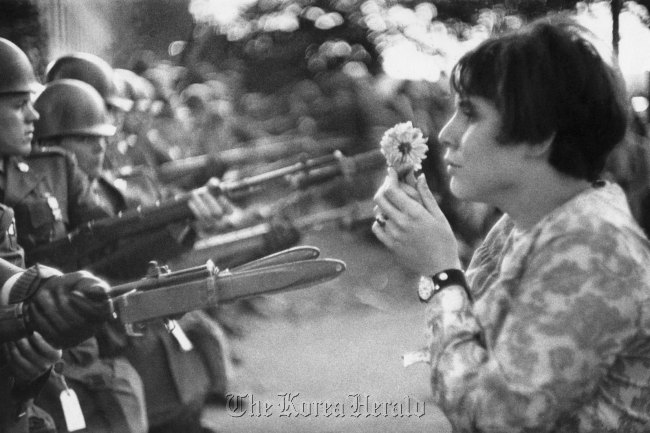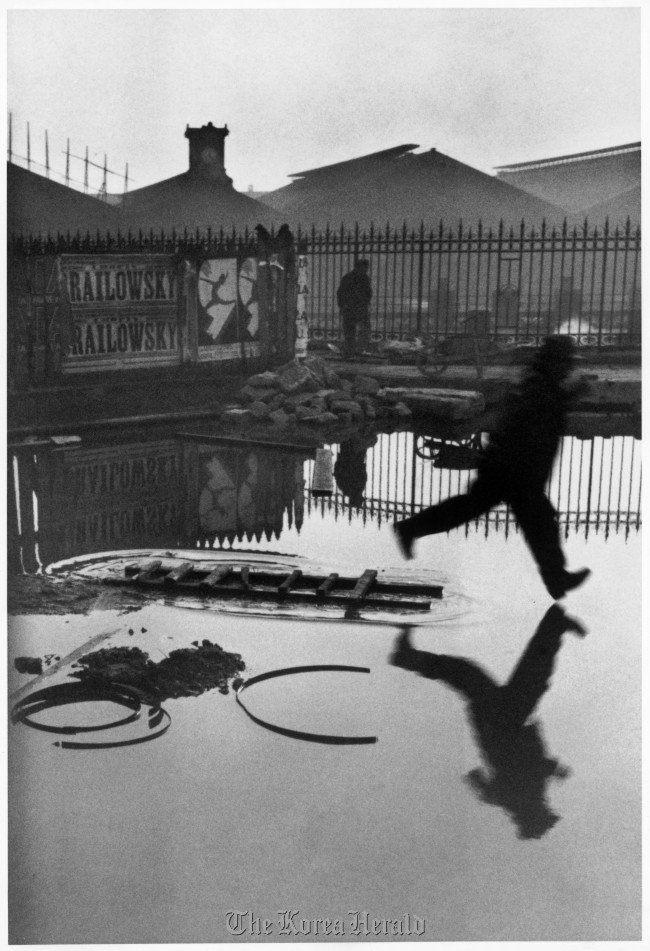Legendary Magnum photographers’ works on exhibit in Seoul
By Lee Woo-youngPublished : June 14, 2012 - 20:05

Perfectly timed shots by Henri Cartier-Bresson and Marc Riboud captivate viewers
Every photographer dreams of capturing a perfect moment that becomes the iconic image of the time.
Separate photo exhibitions of work by two acclaimed Magnum photographers of the 20th century ― Henri Cartier-Bresson and Marc Riboud ― present a series of perfect moments that leave a lasting impact.
Looking at photos by Cartier-Bresson makes viewers wonder how long the photographer must have waited and how carefully he must have calculated to create the perfectly arranged compositions. Cartier-Bresson, who died in 2004, is a co-founder of the photography agency Magnum.
“This exhibition draws on a unique selection of material brought together for a major exhibition, including Cartier-Bresson’s very earliest photographs, some never seen before. It is a selection of the best images that constitute the core of Cartier-Bresson’s photographic oeuvre; books, monographs, histories and portfolios,” wrote the exhibition curator Robert Delpire.
The Seoul exhibition, titled “De quoi s’Agit-il? (What are we Dealing With?),” is the 11th retrospective of Cartier-Bresson held worldwide starting in France in 2003. The photographer died shortly after his retrospective started.
Perfect geometry and dynamism constitute Cartier-Bresson’s photographs, many of which portray everyday life.
He enjoyed playing with shadow to create geometric figures from houses, objects and added dynamic movement by capturing children running.
When the right moment came, he captured it out of instinct.
One of his famous photos features a man jumping over a puddle of water behind the Saint Lazare train station in Paris.
Cartier-Bresson happened to be peeking through a gap when the man jumped and Cartier-Bresson captured that just that moment for a photo that has inspired many other photographers over generations.
Not only the physical scenes but the atmosphere and feeling when the photo was taken still live on in his photos, as in the picture in which Muslim women are praying on top of a hill in Srinagar in Kashmir in 1948 looking up at the rising sun early in the morning.
Cartier-Bresson documented some of the important historical moments of the 20th century, including the assassination of Mahatma Gandhi, the establishment of the Berlin Wall, collapse of Kuomintang in China in 1948.
But instead of capturing key figures of the historical moments, he observed the moments through the perspectives of children and ordinary citizens.
When the Berlin Wall was erected, he took a photo of three men watching with curiosity what lay behind the wall when it suddenly divided German, showing what the historical moment meant to ordinary people.
Another famous Magnum photographer Marc Riboud’s lifetime works are being introduced in Korea for the first time.
Marc Riboud, an engineer-turned-photographer, was 30 years old when he met Cartier-Bresson and Robert Capa in 1952.
Riboud captured geometric beauty in the structure of Eiffel Tower where he took the famous shot of a painter motioning like a dancer, which gained him international reputation after it was posted in the Life magazine.
But to take the perfect shot, he used up more than a roll of film and braved dangerous moments following the movements of the painters without any safety gear.
“The exhibition shows a lifetime of works by the photographer for the first time to Korean people and it is not something that is held to follow a current exhibition trend,” said the exhibition curator Lee Hae-min of the Marc Riboud Retrospective photo exhibition.
Like Cartier-Bresson, Riboud enjoyed the contrast between light and shade and harmony of geometry and dynamism.
Riboud was one of the few European photographers to reveal China during the Cultural Revolution and Japan when it opened its doors to Western culture and trade following the end of World War II.
Riboud, who became a close friend of Mao Zedong, took pictures of the Chinese leader’s bedroom for the first time. But, at the same time, he also captured the tired faces and street scenes of China under Mao. Standing in the center of a historical upheaval, Riboud tried to capture the ordinary people’s lives in Luilichang streets in Beijing in 1965 seen from a window divided into five frames.
Unlike Cartier-Bresson who mostly took portraits of artists he admired, Riboud took key social figures of the time including Winston Churchill, Ho Chi Minh, the young Dalai Lama, Fidel Castro and artists including the Beatles, Audrey Hepburn, Yves-saint Laurent and Gong Li.
Riboud’s works feature humo in unexpected and disconnected subjects.
Every photographer dreams of capturing a perfect moment that becomes the iconic image of the time.
Separate photo exhibitions of work by two acclaimed Magnum photographers of the 20th century ― Henri Cartier-Bresson and Marc Riboud ― present a series of perfect moments that leave a lasting impact.
Looking at photos by Cartier-Bresson makes viewers wonder how long the photographer must have waited and how carefully he must have calculated to create the perfectly arranged compositions. Cartier-Bresson, who died in 2004, is a co-founder of the photography agency Magnum.
“This exhibition draws on a unique selection of material brought together for a major exhibition, including Cartier-Bresson’s very earliest photographs, some never seen before. It is a selection of the best images that constitute the core of Cartier-Bresson’s photographic oeuvre; books, monographs, histories and portfolios,” wrote the exhibition curator Robert Delpire.
The Seoul exhibition, titled “De quoi s’Agit-il? (What are we Dealing With?),” is the 11th retrospective of Cartier-Bresson held worldwide starting in France in 2003. The photographer died shortly after his retrospective started.
Perfect geometry and dynamism constitute Cartier-Bresson’s photographs, many of which portray everyday life.
He enjoyed playing with shadow to create geometric figures from houses, objects and added dynamic movement by capturing children running.
When the right moment came, he captured it out of instinct.
One of his famous photos features a man jumping over a puddle of water behind the Saint Lazare train station in Paris.
Cartier-Bresson happened to be peeking through a gap when the man jumped and Cartier-Bresson captured that just that moment for a photo that has inspired many other photographers over generations.
Not only the physical scenes but the atmosphere and feeling when the photo was taken still live on in his photos, as in the picture in which Muslim women are praying on top of a hill in Srinagar in Kashmir in 1948 looking up at the rising sun early in the morning.
Cartier-Bresson documented some of the important historical moments of the 20th century, including the assassination of Mahatma Gandhi, the establishment of the Berlin Wall, collapse of Kuomintang in China in 1948.
But instead of capturing key figures of the historical moments, he observed the moments through the perspectives of children and ordinary citizens.
When the Berlin Wall was erected, he took a photo of three men watching with curiosity what lay behind the wall when it suddenly divided German, showing what the historical moment meant to ordinary people.
Another famous Magnum photographer Marc Riboud’s lifetime works are being introduced in Korea for the first time.
Marc Riboud, an engineer-turned-photographer, was 30 years old when he met Cartier-Bresson and Robert Capa in 1952.
Riboud captured geometric beauty in the structure of Eiffel Tower where he took the famous shot of a painter motioning like a dancer, which gained him international reputation after it was posted in the Life magazine.
But to take the perfect shot, he used up more than a roll of film and braved dangerous moments following the movements of the painters without any safety gear.
“The exhibition shows a lifetime of works by the photographer for the first time to Korean people and it is not something that is held to follow a current exhibition trend,” said the exhibition curator Lee Hae-min of the Marc Riboud Retrospective photo exhibition.
Like Cartier-Bresson, Riboud enjoyed the contrast between light and shade and harmony of geometry and dynamism.
Riboud was one of the few European photographers to reveal China during the Cultural Revolution and Japan when it opened its doors to Western culture and trade following the end of World War II.
Riboud, who became a close friend of Mao Zedong, took pictures of the Chinese leader’s bedroom for the first time. But, at the same time, he also captured the tired faces and street scenes of China under Mao. Standing in the center of a historical upheaval, Riboud tried to capture the ordinary people’s lives in Luilichang streets in Beijing in 1965 seen from a window divided into five frames.
Unlike Cartier-Bresson who mostly took portraits of artists he admired, Riboud took key social figures of the time including Winston Churchill, Ho Chi Minh, the young Dalai Lama, Fidel Castro and artists including the Beatles, Audrey Hepburn, Yves-saint Laurent and Gong Li.
Riboud’s works feature humo in unexpected and disconnected subjects.

A photo taken in front of the Notre Dame Cathedral in Paris in 1953 shows a nun who tried to catch a taxi looking up to see the photographer like she’s caught doing something bad and an elegant-looking rich lady giving her a stern look.
The train station was a place where Riboud found many unexpected funny moments.
Another picture, taken at the Lyon train station in Paris, features travelers sitting on a platform with one couple kissing each other and the other lowering his head as if trying to avoid the awkward moment.
Henri Cartier-Bresson’s solo exhibition continues through Sept. 2 at Sejong Arts Center.
Marc Riboud’s exhibition runs until Aug. 5 at Seoul Arts Center.
For more information, call (02) 735-4237 for the Cartier-Bresson exhibition and (02) 532-4407 for the Marc Riboud exhibition.
By Lee Woo-young (wylee@heraldcorp.com)


![[AtoZ into Korean mind] Humor in Korea: Navigating the line between what's funny and not](http://res.heraldm.com/phpwas/restmb_idxmake.php?idx=644&simg=/content/image/2024/04/22/20240422050642_0.jpg&u=)
![[Exclusive] Korean military set to ban iPhones over 'security' concerns](http://res.heraldm.com/phpwas/restmb_idxmake.php?idx=644&simg=/content/image/2024/04/23/20240423050599_0.jpg&u=20240423183955)


![[Graphic News] 77% of young Koreans still financially dependent](http://res.heraldm.com/phpwas/restmb_idxmake.php?idx=644&simg=/content/image/2024/04/22/20240422050762_0.gif&u=)

![[Herald Interview] Why Toss invited hackers to penetrate its system](http://res.heraldm.com/phpwas/restmb_idxmake.php?idx=644&simg=/content/image/2024/04/22/20240422050569_0.jpg&u=20240422150649)





![[Exclusive] Korean military to ban iPhones over security issues](http://res.heraldm.com/phpwas/restmb_idxmake.php?idx=652&simg=/content/image/2024/04/23/20240423050599_0.jpg&u=20240423183955)



![[Today’s K-pop] Ateez confirms US tour details](http://res.heraldm.com/phpwas/restmb_idxmake.php?idx=642&simg=/content/image/2024/04/23/20240423050700_0.jpg&u=)